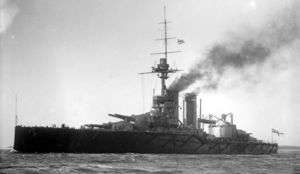King George V-class battleship (1911)
 | |
| Class overview | |
|---|---|
| Name: | King George V class |
| Operators: |
|
| Preceded by: | Orion class |
| Succeeded by: | Iron Duke class |
| In commission: | 1912–24 |
| Planned: | 4 |
| Completed: | 4 |
| Lost: | 1 |
| Retired: | 3 |
| General characteristics | |
| Type: | Battleship |
| Displacement: | 23,400 tonnes |
| Length: | 598 ft (182.3 m) |
| Beam: | 89 ft (27.1 m) |
| Draught: | 28 ft (8.5 m) |
| Propulsion: |
|
| Speed: | 21 knots (39 km/h; 24 mph) |
| Armament: |
|
| Armour: | |
The King George V-class battleships were a series of four Royal Navy super-dreadnought battleships built just prior to and serving in the First World War. The King George V class immediately followed the Orion class upon which they were based.
Design
These ships were of slightly larger displacement than the Orions; the extra tonnage allowed for some small enhancements that were incorporated into the design. The most obvious differences in appearance, compared to the Orions, were the repositioning of the main mast and fore-funnel, and the conspicuously slab sided funnels themselves.
They used the same 13.5-inch Mark V gun, but fired a slightly heavier (1,400 lb (635 kg) as against 1,250 lb (567 kg)) shell. Their secondary armament was re-arranged to improve fire distribution ahead, which had been indicated by tactical modelling to be the most effective direction of attack for enemy torpedo boats.
Armour was slightly redistributed and, it was thought, improved. Underwater protection was also improved, although these changes did not save Audacious when she struck a single German mine late in 1914.
There were slight revisions to the superstructure and masts. The engine and boiler arrangements were the same as the Orions with 27,000 SHP giving a design speed of 21 knots (39 km/h; 24 mph) but Centurion achieved a best recorded speed of 22.5 knots (41.7 km/h; 25.9 mph).
Overall, they were a successful design, although received without particular enthusiasm by the public and press. They had been substantially promoted as a great advance over the Orions. In particular, it was expected that they would carry 6 inch guns as their secondary armament. In fact it was the subsequent Iron Duke class that first received 6 inch secondaries.
Service

The ships remaining after the end of the First World War were all decommissioned in the 1920s to allow for the two Nelson-class battleships under the Washington Naval Treaty.
Ships in the class
| Name | Builder | Laid down | Launched | Completed | Operations | Fate |
|---|---|---|---|---|---|---|
| King George V (ex-Royal George) |
HM Dockyard, Portsmouth | 16 January 1911 | 9 October 1911 | November 1912 | Battle of Jutland | Decommissioned in 1919 and scrapped in 1926 |
| Centurion | 16 January 1911 | 18 November 1911 | May 1913 | Battle of Jutland, Operation Neptune | Converted to a target ship in 1927, converted to a decoy 1941/42 and sunk as a breakwater in June 1944 | |
| Audacious | Cammell Laird | March 1911 | 14 September 1912 | August 1913 | Struck a mine off Northern Ireland and sank on 27 October 1914 | |
| Ajax | Scotts Shipbuilding and Engineering Company, Greenock | 27 February 1911 | 21 March 1912 | 31 October 1913 | Battle of Jutland | Decommissioned in 1924 and sold for scrap on 9 November 1926 |
See also
- List of battleship classes
- Lists of ship launches in: 1911, 1912
- List of ship commissionings in 1913
- Lists of shipwrecks in: 1914, 1944
References
Robert Gardiner: Conway's All the World’s Fighting Ships 1922–1946, Conway Maritime Press London 1980
- Gardiner, Robert; Gray, Randal, eds. (1984). Conway's All the World's Fighting Ships: 1906–1922. Annapolis: Naval Institute Press. ISBN 0-87021-907-3.
- Jane's Fighting Ships 1919.
External links
| Wikimedia Commons has media related to King George V class battleship (1911). |
- Dreadnought Project Technical material on the weaponry and fire control for the ships